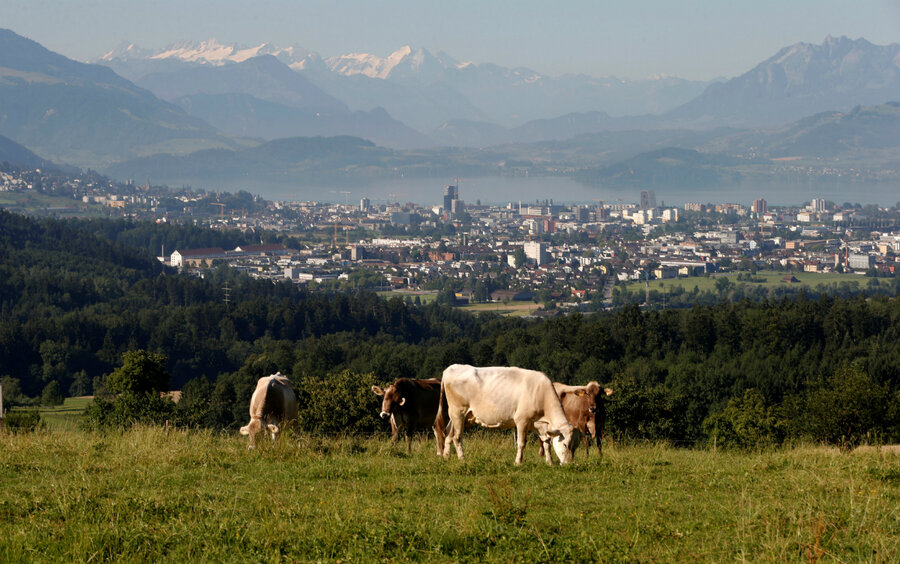In global warming fight, new tactics to make cows burp less
Loading...
| Rome
From New Zealand to the United States and Kenya to Colombia, scientists are on a mission to fight global warming by making livestock less gassy.
Livestock are responsible for about 14.5 percent of global greenhouse gas emissions, according to the United Nations' Food and Agriculture Organization (FAO).
According to calculations by some experts, this puts the livestock sector on par with transport. The UN's Intergovernmental Panel on Climate Change says transport is responsible for 14 percent of emissions.
Ruminants such as cattle, buffalo, sheep, and goats produce nitrous oxide, carbon dioxide, and methane, which is the most emitted gas and is released through belching.
Scientists are working on ways to reduce those emissions, including by breeding animals that burp less, adjusting their diets so they produce less methane, and planting trees in pastures.
"We domesticated ruminants over 10,000 years ago and relatively little has changed. It's time that got an upgrade," said Elizabeth Latham, co-founder of Texas-based Bezoar Laboratories.
Her company is working on a type of probiotic – helpful bacteria or yeasts in the digestive system – which has shown a 50 percent reduction of methane emissions in cattle during research.
Although less prevalent than carbon dioxide, the main greenhouse gas, methane is more potent because it traps 28 times more heat, according to a 2016 study by the Global Carbon Project, which groups climate researchers.
Bezoar's probiotic can be put in water or feed, and even sprinkled on grass, said Ms. Latham, who won a Unilever Young Entrepreneurs Award in 2017 for the patent-pending product.
Thousands of miles away, New Zealand's AgResearch has bred sheep to produce 10 percent less methane.
"In a single sheep, a 10 percent drop maybe not so significant. But when there's 19 million sheep in the country, it starts to make a huge impact," said Suzanne Rowe, a geneticist at the government institute.
The low-methane sheep are the result of a decade of research, and they are also leaner and grow more wool, she said.
"The beauty of breeding the animal to be low methane … is it's permanent," Ms. Rowe told the Thomson Reuters Foundation, adding the team is conducting similar research on cattle and deer.
Agriculture accounts for nearly half of New Zealand's total greenhouse gas emissions, and transforming the sector is key to meeting the target of becoming carbon neutral by 2050, Climate Change Minister James Shaw has said.
Attempts to reduce methane emissions from livestock are not limited to the world's most affluent nations.
In India, a national program to boost the milk production of cows and buffalos by improving their diet is also helping the environment, according to Rajesh Sharma, senior manager at the National Dairy Development Board (NDDB).
The NDDB uses software to assess the ideal diet for an animal, based on its physical profile and environment. Changes usually include adjusting the feed quantity and adding locally-available mineral supplements.
The tailored diet means each animal produces 12 to 15 percent less methane, according to Mr. Sharma.
Over the past five years, the program has reached about 2.6 million of the nearly 300 million cows and buffalos recorded in India's 2014 livestock census, he said.
In Kenya, scientists are testing various local grasses to see if they improve the productivity of livestock, which would reduce the amount of emissions per kilogram of milk, meat, or eggs.
Cows are placed in respiration chambers where scientists measure the methane emissions from different feeds available in East Africa, said Lutz Merbold, senior scientist at the Mazingira Centre, a Nairobi-based research institution.
Results are expected in mid-2019, according to Mr. Merbold, who hopes to persuade farmers to adjust feed practices by appealing to their concerns on climate change.
"If you have a well-fed cow and drought hits you, it will probably survive longer than a less well-fed cow," he said.
Improvements in productivity alone could reduce up to 30 percent of methane emissions from livestock globally, said Anne Mottet, FAO's livestock policy officer.
Her department has developed a web application that allows farmers and researchers to calculate how changes in animal feed may affect emissions.
Latin American ranchers are experimenting with silvopastoralism – planting trees in pastures where they absorb greenhouse gases and offset emissions, while restoring degraded soil and improving biodiversity.
"They can be different types of trees – for timber, fruit trees, even trees that animals can eat," said Jacobo Arango, a researcher at the Colombia-based International Centre for Tropical Agriculture.
As consumers have become more environmentally conscious, ruminants have been vilified for their emissions, as well as the amount of land and water they require.
Beef farming in particular has been heavily criticized, as it accounts for 41 percent of the livestock sector's greenhouse gas emissions, according to FAO.
In a March report, Greenpeace warned that a continued increase in the consumption of meat and dairy could undermine Paris Agreement targets to stop temperatures from rising more than 35.6 degrees Fahrenheit above pre-industrial times.
The environmental group called for global meat and dairy production and consumption to be cut by half by 2050.
Yet, campaigns to abandon meat sometimes ignore the reality of small-scale farmers in Asia, Africa, and South America who depend on animals for their health and livelihoods, according to experts.
Merbold, of the Mazingira Centre, said consumers in richer countries have the privilege of turning away from meat-heavy diets.
"But if you're living in certain regions in Africa, livestock provides you with essential nutrition you can't get somewhere else," he said.
The animals are also used to transport water and plow land, as well as producing manure to fertilize crops, said FAO's Mottet.
What is needed is balance, she said.
"We have countries that consume about 220.462 lbs of meat [per person each year]. In others, it's about four."
This story was reported by the Thomson Reuters Foundation.





